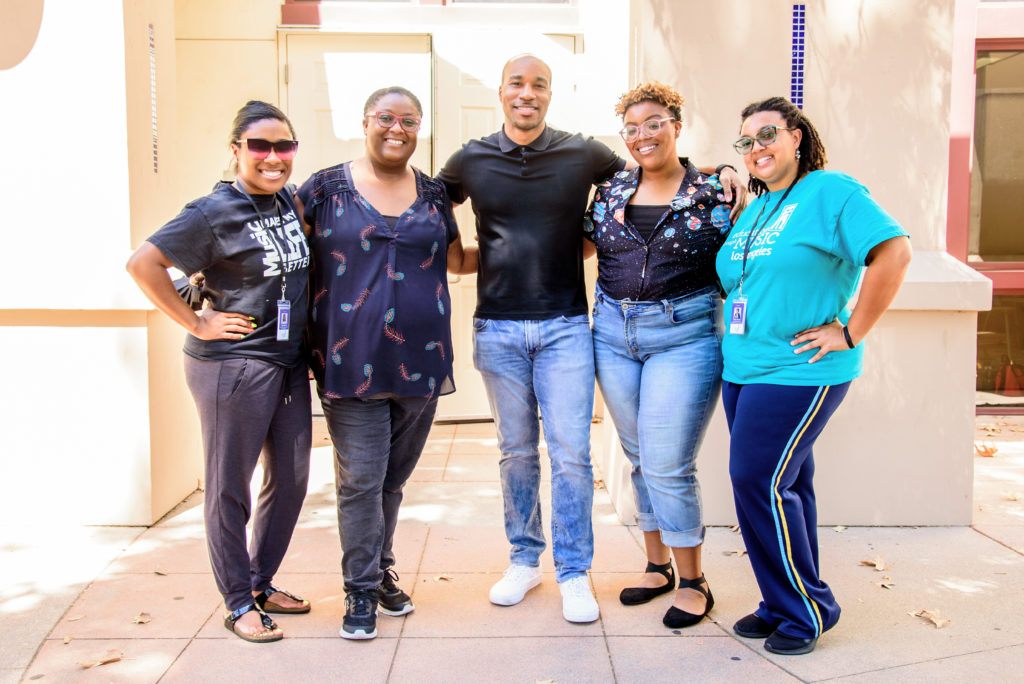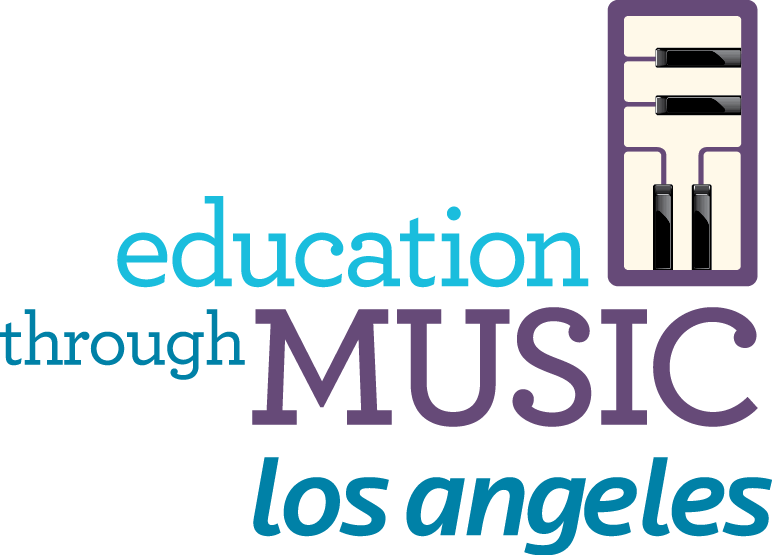HBCUs Impact & Influence

Released: 09/7/2022
Happy HBCU Week, from Education Through Music-LA!
The second week of September is National Historically Black Colleges and Universities (HBCU) Week in the U.S., with the mission to “encourage high-school aged youth to enroll into HBCUs, provide scholarship dollars for matriculation, and sustain a pipeline for employment from undergraduate school to corporate America.” (HBCUWeek.org, 2021)
This year’s HBCU Week conference is focused on the subject “Advancing Educational Equity, Excellence, and Economic Opportunity,” and this hit close to home for ETM-LA. To celebrate and advocate for HBCU Week, we interviewed 5 of our program staff members who are HBCU alumni from 5 different universities.

Tonya Hylton, ETM-LA Instructional Supervisor & Choral Specialist, is a vocalist and educator with a passion for choral conducting and choral music. Tonya holds a Bachelor of Arts in Music Education from Hampton University in Hampton, VA, a Master of Arts in Teaching K-12 Choral and General Music from the University of Southern California, and a Master of Music in Choral Conducting from California State University-Los Angeles. She researched the performance practice essentials that are consistent throughout the history of the spiritual, and the significant historical events that solidified it as a choral art form.
Tiffiny Reckley, ETM-LA Instructional Supervisor & Professional Development Specialist, is a 13-year music education veteran who earned her Bachelor of Music degree in Music Education degree from Xavier University of Louisiana, and a Master of Music Education degree from the University of North Texas. She is extremely passionate about addressing trauma, social emotional learning, and social justice issues in the urban fine arts classroom.
Westley Steele, ETM-LA Music Teacher, is a pianist, composer, music producer, and music educator who graduated Howard University with a Bachelor’s in Music. Westley was a 4-year member of Howard’s “Showtime” Marching Band Sousaphone section. After graduating, He began to write his own music and moved to Los Angeles to pursue the creative industry; he writes in numerous styles of music, including Electropop and for multimedia.
Renee Cannon, ETM-LA Music Teacher, graduated from Lincoln University of Pennsylvania with a Bachelor of Science in Elementary/Early Childhood Education, a Master of Arts in Multiple Subjects from the University of Phoenix, and holds a certificate in Theory, Harmony, and Ear Training from Berklee College of Music. She plays the oboe, tenor sax, and baritone horn, sings Alto in her choir, and strives to learn more about music every day. In college, Renee was in the second generation of students to join the Orange Crush Roaring Lions Marching Band, where she became the section leader of the Baritone Horn section and a member of Tau Beta National Honorary Band Sorority, Incorporated.
Kimberly Johnson, ETM-LA Music Teacher, received her Bachelors of Music Education with a Concentration on Instruments from Grambling State University. She first fell in love with music at a young age and eventually ended up following her dream to play trumpet for Grambling State University’s “World Famed” Tiger Marching Band. Kimberly received opportunities of a lifetime performing for NFL’s Jacksonville Jaguars, performing on live television for the Bayou Classic, being featured on Good Morning America, and even marching in President Obama’s first Inaugural Parade in Washington, D.C.
Why Attend an HBCU?
While each of our educators have their own personal reasons for attending their HBCU, the themes of excellence and Black representation are woven through each of these Alumni interviews. Westley says he wanted “to build camaraderie with the brightest and most creative like-minded students of color from around the world,” while Kimberly says she wanted “to be seen [as a person] and to be in the band.”
Deciding to go to an HBCU began, for most, in high school. Tonya shares, “My high school choir director, Ms. White, is a graduate of Hampton University… I had never heard of it, or even knew what an HBCU was. Growing up in the Northeast portion of the United States, HBCUs weren’t taught about or openly discussed as a viable option.” It is thanks to Ms. White that Tonya found her pathway at Hampton University. For Renee, her school counselor helped introduce her to HBCUs: “My original plan was to attend a school in San Francisco. When I was in high school, however, I had a really invested counselor who brought me and some other African American students to an HBCU college fair.”
Tiffiny highlights that attending an HBCU “allowed me to flourish in an environment that understood the cultural connectedness of Black communities and Black American cultural nuances.” HBCUs provide a safe space where students feel valued, seen, and encouraged. Their unique demographic allows Black students to step into an environment where they are the majority. As Tonya’s choir director told her, “You have your entire life to be a minority.”
Unique History and Traditions
If you ever sit down with an HBCU student or alumnus and ask them about their school, they probably could share with you a long list of fun and historical facts. HBCUs take pride in their history and their traditions. We had the pleasure of learning more about each of the 5 universities represented in these interviews. Here are some of our educators’ favorite school traditions and historical facts about their campuses.
Hampton University
- The Emancipation Oak served as the site for the first Southern reading of the Emancipation Proclamation in 1863. The Emancipation Oak is still standing on the Hampton University campus.
- In 1878, the first group of Native American students attended Hampton Institute at the request of its founder General Chapman Armstrong, and became one of the first Native American programs at a University in the country.
Xavier University of Louisiana
- Alumni will go back to their freshman dorm room during Homecoming and give the current students of that room gifts.
- Xavier will celebrate its Centennial in 2025!
- Xavier produces more African American students who graduate from medical school than any other university in the U.S.
- There’s a neighborhood in the middle of campus. Xavier is built in the Gert Town neighborhood in New Orleans. The University will not purchase these homes for expansion. Xavier has intentionally acquired and built on the land around the neighborhood, and the neighbors love the students.
Howard University
- There are legendary Homecomings at Howard, which have been made famous by celebrity appearances and performances of the hottest black music artists on the planet (examples include Biggie Smalls, Lauryn Hill, Common, and Drake to name a few).
- The University’s motto is Veritas et Utilitas, Truth and Service, and it is ingrained into the classes and students.
- Westley Steele was a member of the “Showtime” Marching Band, which plays at Howard football games and also travels around to perform. Some stops include NFL games.
Lincoln University of Pennsylvania
- LU was the first degree granting college for African-Americans and is very proud of that fact.
- Some incredibly notable alumni are Cab Calloway, Langston Hughes, and Thurgood Marshall.
Grambling State University
- The Grambling “World Famed” Marching Band has performed in different parts of the world and for the first ever Super Bowl Halftime Show.
- The band performed for 5 different presidents: Nixon, Clinton, Bush, Obama, and Biden. Kimberly Johnson even had the opportunity to perform at Obama’s first inauguration. They were featured in movies, tv shows, commercials and more. Known as “The Best Band in the Land”.
- Grambling State University motto “Where Everybody is Somebody”
Community Connectedness
There is a community culture built into everything these schools do. Tonya reflects, “I learned what community really means from Hampton University. It is a smaller university, and being a part of the music department meant classes were even smaller. I think that atmosphere benefitted me.” In Fall 2019, across all 107 HBCUs in the United States, there was an average enrollment of 2,865 students per campus. For many HBCU students, they feel more tight-knit and close due to the campus’ smaller size. Renee shares that Lincoln University is also a smaller school and that it is common for students within the same department to feel very well-connected: “If you were in Elementary Education, you took very nearly every class with the same people.”
That sense of community is now carried into the music classrooms these educators lead. Kimberly expresses that by being at an HBCU, “I got to see how children of color act in an environment where they are most comfortable to express themselves. The culture is way different from what I was used to.” This exposure allows these educators to share a piece of that community with their students. For Tonya, “It taught me how to engage with people who I didn’t know, and feel more comfortable in spaces that might be unfamiliar to me. These strategies helped me figure out how to get my students to connect with one another on a deeper level and create relationships between unlikely individuals.”
HBCUs are very intentional toward students while they are enrolled; Westley comments, “You’re not just a number in the classroom to your professors and/or administrators. They build a relationship with you and guide you through your experience at the institution.” However, it doesn’t stop there. Tiffiny shares, “Our relationship with the University continues after graduation… it is expected that Alumni come back and serve and stay connected. I have enjoyed being able to go back and see former professors, speak with current music education students and other music majors about the future of the profession, and perform as a Distinguished Alumni.”
How HBCUs Develop Quality Music Educators
Throughout the interviews, the sense of pride and honor is flooded through each educator’s responses. Westley states, “I often tell my students that I am not just ‘Mr. Steele the music teacher’, but a mixture of ALL the traits my professors helped instill into my persona as a leader, brother, and servant of higher education to the world.” Tiffiny says, “Everything that I am as an educator was formed and shaped by the educational experience I received at Xavier. I am constantly crediting the University and the high quality of the professors for my continual success.”
The passion these educators have took root in their experiences at their HBCU. These schools not only nurture the skills and talents of their students, but encourage them to grow for the benefit of their communities and future generations. Tiffiny emphasizes, “It’s a wonderful experience to attend a university that doesn’t just focus on academics, but one that really stresses the importance of how you can increase your wider scope of the world. The goal is for these experiences to allow us to be innovative in how we can use our gifts to improve the world around us.” While Westley also takes note of his school’s dedication to service: “You’re nurtured to become a leader and to always give back to anyone who may require your assistance.”
As music educators, social-emotional learning (SEL), culturally responsive teaching (CRT), and cultural equity and inclusion (CEI) play an integral role in the music classroom. Many HBCUs emphasize these principles and embed them into the curriculum. Tiffiny shares, “We were encouraged to absorb the language, music, and culture of the city and infuse it back into teaching our students.” Tonya reflects, “It made me really consider how I was presenting musical concepts, making sure that content was relatable, current, and relevant to the students and the lives they led outside. I ended up doing an entire overhaul of my curriculum, and making sure the material that I was presenting always included something relatable or recognizable to the students.” Also, becoming resourceful is vital to fulfilling certain culturally responsive lessons. Kimberly says her university “prepared us for the real possibility that we would have limited resources… I believe that idea of being resourceful and finding creative solutions helps me think outside the box of what I can bring into my classroom.”
Most of these educators were also part of their school’s marching band. Renee reflects on the additional development that comes with this experience: “In the marching band, I learned a lot about responsibility, discipline, and ownership. There were a lot of expectations for how we should present and conduct ourselves, whether we were in the band room, the stands, the field, or out and about.” The culture of marching runs deep for HBCUs and often shapes students into world-class players.
How do you uphold the legacy of your HBCU?
As part of HBCU Week, we wanted our HBCU alumni to share how they carry on their school legacy in the music classroom.
Tonya shares that she makes it a point to “discuss HBCUs with the teachers I supervise, to assist them with understanding the significance these schools have on Black and Indigenous populations.” As an Instructional Supervisor, Tonya works with many of our partner schools and says she represents Hampton University “even in something as simple as wearing my college t-shirt or sweatshirt.”
For Tiffiny, “Xavier’s mission is to “create a more just and humane society” through servant leadership… My own personal mission of helping students gain a wider scope of the world, envision themselves as integral members of the arts community, and to become social justice change agents in their communities through the performing arts, is centered around what was embedded in me as a student at Xavier.”
Westley likes to bring HBCUs into the music classroom; he states, “I love to present video clips of HBCU choirs and bands to inspire students to turn the key and ask questions about how these institutions, these safe spaces of diverse education, can foster a sense of excitement, tradition, and belonging for everyone who attends.”
Renee also brings her school’s mission into her classroom: “Lincoln believes that the students who walk through their gates will be the students making news tomorrow. It’s important to me that my students understand that they too can be making an impact, that they too can be the ones making history.”
Kimberly strives to “represent my university and be able to share my experiences that hopefully inspire all my students to be the best versions of themselves. I want my classroom to carry the same motto as my school: Grambling State University ‘Where Everybody is Somebody.’”
At Education Through Music-LA, we are proud to feature HBCUs and alumni whose work continues to generate positive impact across our communities and world. We are proud to feature these team members who are dedicated to bringing equity and access to high quality music education for every student. HBCUs have helped prime and prepare these educators for their work in the music classroom. Their commitment, talent, drive, and innovation are cherished and cultivated through the ETM model. Our most recent teaching training, the 2022 Summer Academy, featured these educators as presenters and leaders.
ETM-LA continues to increase positive outcomes and create systemic change through providing multifaceted and culturally relevant music instruction. To harness the full power of equity, diversity, and inclusion as a force to strengthen our mission, instruction, staffing, and the communities we serve, ETM-LA strives to continually learn, listen, and partner with others who share in our mission.
Additional Resources:
https://nces.ed.gov/programs/digest/d21/tables/dt21_313.10.asp
https://howard.edu/about/about-howard
https://sites.ed.gov/whhbcu/hbcu-week-conference/2022-national-hbcu-week/





